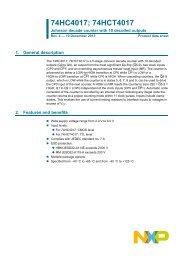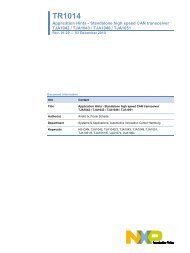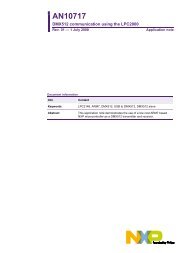AN108711 - NXP Semiconductors
AN108711 - NXP Semiconductors
AN108711 - NXP Semiconductors
Create successful ePaper yourself
Turn your PDF publications into a flip-book with our unique Google optimized e-Paper software.
Philips <strong>Semiconductors</strong><br />
3.6.3 NFCIP-1 Target (Active communication, all three speeds)<br />
Application Note<br />
Tips and Tricks for PN51x Integration<br />
When the Initiator sends an initial ATR_REQ, the target has to react within a certain time<br />
frame. More precisely the Target has to switch on its RF field to notify the Initiator that a<br />
response to the request will follow. There is no timing constraint (according to ECMA340)<br />
between switching on the RF field and sending the response (ATR_RES). The ATR_RES<br />
can now send a new time-out value to the Initiator. This value is then valid for all the<br />
consecutive command interchanges. The time-out has the minimum value of 302us and<br />
the maximum value of 5s. The default value is 4.8ms. (Please refer to chapter 12.5.2.1 in<br />
the ECMA340 standard for more details).<br />
3.6.4 NFCIP-1 Target (passive communication, all three speeds)<br />
According to the ISO/IEC 18092 the ATR_RES has to be sent within the maximum timeout.<br />
This value is set to 4,949 seconds. This timeout can be lowered by the byte TO<br />
which is conveyed in the ATR_RES command itself. This value is then valid for all the<br />
commands, which follow (even for DSL, RLS).<br />
3.6.5 FeliCa Card<br />
The initialization phase (including sending the POLLING_RES) is automatically done by<br />
the PN51x. Further commands are Sony proprietary and have to be handled exclusively<br />
by the host controller.<br />
© Koninklijke Philips Electronics N.V. 2006. All rights reserved.<br />
Application note Rev. 01.10 — 11. May 2006 21 of 37





